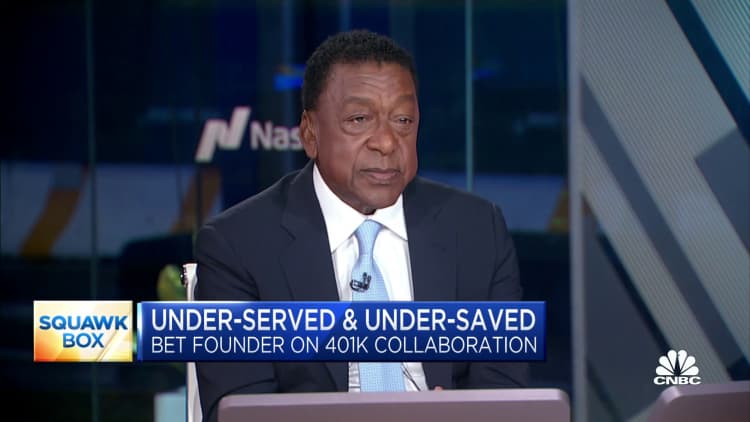JGI | Jamie Grill | Mix images | Getty
401(k) plans hold $7.7 trillion in retirement savings. But withdrawals from small accounts squeeze billions out of the system every year and can hurt investors’ chances of having a secure retirement, research shows.
A trio of the industry’s top 401(k) administrators — Fidelity Investments, Vanguard Group and Alight Solutions — have teamed up to change that.
Along with Retirement Clearinghouse, they created a consortium — Portability Services Network, LLC — to automatically reconnect workers with old 401(k) accounts they may have lost or left behind after leaving a job.
The partnership, which the companies call the first of its kind for the industry, aims to address what they see as a structural flaw in the current retirement system in the United States.
Learn more about personal finance:
How to invest before a recession
Americans prioritize Amazon Prime and Netflix over food spending
More car buyers are paying at least $1,000 a month for their loans
If workers leave behind 401(k) accounts with less than $1,000, current rules allow employers to cash the funds and issue a check. This withdrawal can be accompanied by taxes and penalties if the funds are not transferred to a new qualified retirement plan within a short period of time.
Employers generally cannot cash accounts of $1,000 or more. But they can transfer those with $1,000 to $5,000 to a 401(k) and into an Individual Retirement Account, where — unless the employee takes action — the funds are often by default invested in cash in their name, a strategy inconsistent with building a nest egg over decades, experts said.
Employee- and employer-initiated cash withdrawals are a ‘serious problem’ that led to $92.4 billion being withdrawn from 401(k) plans in 2015, according to the latest Data from the Employee Benefits Research Institute.
According to EBRI, automatically reconnecting workers to accounts with less than $5,000 could add up to $1.5 trillion kept in the retirement system over 40 years.
“Billions of dollars are left behind or just taken in, and [workers] pay taxes on it and spend it, which is not good for their long-term retirement savings,” said Philip Chao, a certified financial planner and founder of Experiential Wealth in Cabin John, Maryland.

How the new consortium will work
This is where the new consortium of plan administrators comes in. When a worker changes jobs and has $5,000 or less in their account, Fidelity, Vanguard, and Alight automatically transfer 401(k) assets to the employee’s new work plan when possible. Basically, the money will follow the worker.
The worker can choose to cash out at that time, although Dave Gray, head of workplace retirement platforms at Fidelity, expects more than 90% will choose to keep the money invested.
And it’s not just 401(k) balances — the transfers will also apply to similar work plans outside the private sector, including 403(b), 401(a), and 457 plans. minorities and low-income savers will benefit the most, as they disproportionately have account balances below $5,000, Gray said.
“This money matters and it is essential,” he said.
Taking money out over an investor’s lifetime increases the odds of running out of money in retirement by 11.4 percentage points, on average, to 30.4%; two or more increases the chance to 46.4%, according at EBI.
If the participant falls outside the universe of these three companies, you have not really improved the result.
Philip Chao
founder of Experiential Wealth
As it stands, there’s a loophole: Companies can only facilitate the transaction if workers move to or from an employer with a pension plan administered by Fidelity, Vanguard or Alight.
“If the participant is outside of the universe of these three companies, you haven’t really improved the outcome,” Chao said.
Companies represent about 44 million people, or about 40% of total investors, in workplace pension plans. They work collectively with 48,000 employer-sponsored pension plans.
Their aim is to expand the list of companies in the consortium in order to increase the number of investors who can benefit from it.
Stemming ‘leaks’ as 401(k) auto-enrollment increases
Martin Leigh | Source of images | Getty Images
So-called “leaks” from the retirement system due to cash outs have become a more widespread problem as workers change jobs more frequently and more employers automatically enroll workers in their company 401( k), Chao said. This latter dynamic increases the number of overall savers, but can also create many small accounts of which their owners are unaware.
Retirement Clearinghouse serves as the engine facilitating transfers between administrators and will manage day-to-day operations, Gray said. Companies charge workers a one-time fee for the service: 5% of account balance, capped at $30. Accounts under $50 are not charged.
Fees should decrease over time, Gray said. The service is designed as a utility for retirement savers and the consortium operates at breakeven costs, he added.
Admins can also benefit from more money remaining in the system. Many companies earn income based on a percentage of a pension plan’s assets; if more money stays in the system, more revenue will likely follow.
But the industry has moved away from an asset-based fee model to one that charges based on the total number of investors in a plan, meaning the new service isn’t necessarily a ” financial gain” for the directors, Gray said.
